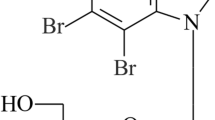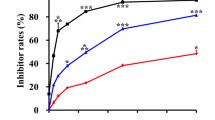Abstract
UCN-01 (7-hydroxy-staurosporine), a selective inhibitor of protein kinase C (PKC), was shown to exhibit antitumor activity in murine and human tumor cell lines in vitro and in vivo. On the other hand, staurosporine, a nonselective protein kinase inhibitor, was not shown to exert antitumor activity in vivo despite its potent antiproliferative activity in vitro. To compare the modes of action of UCN-01 and staurosporine in vitro, the effects of both drugs on the cell cycle progression of human epidermoid carcinoma A431 cells were examined by flow cytometry using propidium iodide (PI) staining. At 50% growth inhibitory concentrations, both UCN-01 and staurosporine induced G1 phase accumulation in the cell cycle. At 80% growth inhibitory concentrations, UCN-01 also induced preferential G1 phase accumulation, but staurosporine mostly induced G2M phase accumulation. Staurosporine also induced higher DNA ploidy when the cells were exposed to the drug for more than one generation time of A431 cells. An analysis of cell kinetics by 5-bromo-2-deoxyuridine incorporation versus DNA content confirmed that the G1 phase block by UCN-01 and the G1 and G2M phase block by staurosporine at the respective doses, as was the case for PI staining. Additionally, DNA synthesis of the cells, which was determined by the uptake of3H-TdR, was not suppressed at least 8 h after the treatment with UCN-01. These results suggested that UCN-01 could affect the G1 phase of cell cycle in A431 cells in quite different manners from staurosporine. The G1 phase block induced by UCN-01 might be important for the growth inhibitory activity of UCN-01 against A431 cells in vitro and in vivo.
Similar content being viewed by others
Abbreviations
- PKC:
-
Ca2+ and phospholipid-dependent serine/threonine kinase
- PBS:
-
phosphate buffered saline
- PI:
-
propidium iodide
- FITC:
-
fluorescein isothiocyanate
- cPKC:
-
conventional PKC including
- PKC α:
-
β and γ
- nPKC:
-
neo PKC including PKC δ, ε, η (L) and θ
- IC50 :
-
concentration required for 50% growth inhibition
- IPA:
-
phorbol 12-myristate 13-acetate
References
Abe K, Yoshida M, Usui T, Horinouchi S, Beppu T (1991) Highly synchronous culture of fibroblasts from G2 block caused by staurosporine, a potent inhibitor of protein kinases. Exp Cell Res 192: 122–127
Akinaga S, Gomi K, Morimoto M, Tamaoki T, Okabe M (1991) Antitumor activity of UCN-01, a selective inhibitor of protein kinase C, in murine and human tumor models. Cancer Res 51: 4888–4892
Akinaga S, Nomura K, Gomi K, Okabe M (1992) Synergistic antitumor effect of UCN-01, a protein kinase (C) inhibitor, combined with various anti-cancer agents. Proc Am Assoc Cancer Res 29: 3072
Akinaga S, Nomura K, Gomi K, Okabe M (1993) Enhancement of antitumor activity of mitomycin C in vitro and in vivo by UCN-01, a selective inhibitor of protein kinase C. Cancer Chemother Pharmacol 32: 183–189
Bhuyan BK, Gropp VE (1989) Cell cycle specific inhibitors. Pharm Ther 42: 307–348
Bruno S, Ardelt B, Skierski JS, Traganos F, Darzynkiewicz Z (1992) Different effects of staurosporine, an inhibitor of protein kinases, on the cell cycle and chromatin structure of normal and leukemic lymphocytes. Cancer Res 51: 470–473
Crissman HA, Gadbois DM, Tobey RA, Bradbury EM (1991) Transformed mammalian cells are deficient in kinase-mediated control of progression through the G1 phase of the cell cycle. Proc Natl Acad Sci USA 88: 7580–7584
Gadbois DM, Hamaguchi JR, Swank RA, Bradbury EM (1992) Staurosporine is a potent inhibitor of p34cdc2 and p34cdc2-like kinases. Biochem Biophys Res Commun 184: 80–85
Gadbois DM, Crissman HA, Tobey RA, Bradbury EM (1992) Multiple kinase arrest points in the G1 phase of nontransformed mammalian cells are absent in transformed cells. Proc Natl Acad Sci USA 89: 8626–8630
Giard DJ, Aaronson SA, Todaro GJ, Arnstein P, Kersey JH, Dosik H, Parks WP (1973) In vivo cultivation of human tumors: establishment of cell lines derived from a series of solid tumors. J Natl Cancer Inst 51: 1417–1423
Howe LR, Leevers SJ, Gomez N, Nakielny S, Cohen P, Marshall CJ (1992) Activation of the MAP kinase pathway by the protein kinase raf. Cell 71: 335–342
Hunter T, Pines J (1991) Cyclins and cancer. Cell 66: 1071–1074
Kirschner M (1992) The cell cycle then and now. Trends Biol Sci 17: 281–285
Levin DE, Fields OF, Kunisawa R, Bishop JM, Thorner JA (1990) A candidate protein kinase C gene, PKC1, is required for theS. cerevisiae cell cycle. Cell 62: 213–224
Meier KE, Licciardi KA, Haystead TAJ, Krebs EG (1990) Activation of messenger-independent protein kinases in wild-type and phorbol ester-resistant EL4 thymoma cells. J Biol Chem 266: 1914–1920
Norbury C, Nurse P (1992) Animal cell cycles and their control. Annu Rev Biochem 61: 441–470
Ohno S, Akita Y, Hata A, Osada S, Kubo K, Konno Y, Akimoto K, Mizuno K, Saido T, Kuroki T, Suzuki K (1991) Structural and functional diversities of a family of signal transducing protein kinases, protein kinase C family; two distinct classes of PKC, conventional cPKC and novel nPKC. Adv Enzyme Regul 31: 287–303
Osada H, Koshini H, Kudo T, Onose R, Isono K (1992) A new inhibitor of protein kinase C, RK-1409 (7-oxostaurosporine) I. Taxonomy and biological activity. J Antibiot (Tokyo), 45: 189–198
Pelech SL, Sanghera JS (1992) Mitogen-activated protein kinases: versatile transducers for cell signaling. Trends Biol Sci 17: 233–238
Takahashi I, Saitoh Y, Yoshida M, Sano H, Nakano H, Morimoto M, Tamaoki T (1989) UCN-01 and UCN-02, new selective inhibitors of protein kinase C. II. Purification, physico-chemical properties, structural elucidations and biological activities. J Antibiot (Tokyo) 42: 571–576
Takahashi I, Kobayashi E, Nakano H, Murakata C, Saitoh H, Suzuki K, Tamaoki T (1990) Potent selective inhibition of 7-O-methyl UCN-01 against protein kinase C. J Pharmacol Exp Ther 255: 1218–1221
Tamaoki T, Nakano H (1990) Potent and specific inhibitors of protein kinase C of microbial origin. Biotechnology 8: 732–735
Tamaoki T, Nomoto T, Takahashi I, Kato Y, Morimoto M, Tomita F (1986) Staurosporine, a potent inhibitor of phospholipid/Ca2+-dependent protein kinase. Biochem Biophys Res Commun 135: 397–402
Thoma G (1992) MAP kinase by any other name smells just as sweet. Cell 68: 3–6
Usui T, Yoshida M, Abe K, Osada H, Isono K, Beppu T (1991) Uncoupled cell cycle without mitosis induced by a protein kinase inhibitor, K-252a. J Cell Biol 115: 1275–1282
Author information
Authors and Affiliations
Rights and permissions
About this article
Cite this article
Akinaga, S., Nomura, K., Gomi, K. et al. Effect of UCN-01, a selective inhibitor of protein kinase C, on the cell-cycle distribution of human epidermoid carcinoma, A431 cells. Cancer Chemother. Pharmacol. 33, 273–280 (1994). https://doi.org/10.1007/BF00685899
Received:
Accepted:
Issue Date:
DOI: https://doi.org/10.1007/BF00685899




